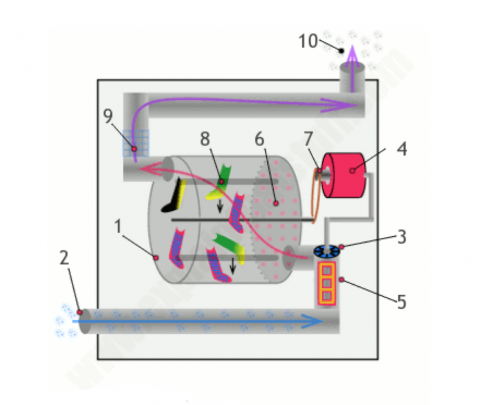Washing machines do a great job of rinsing away the sweat and grime our garments pick up each day, but they have one little drawback: they give you back your clothes clean but soaking wet! Before you can put your t-shirt and jeans back on, you need to get rid of a huge amount of water, via drying your clothes. If you understand a little bit of the science behind drying your clothes, you'll find you can do your laundry a whole lot more quickly and economically. So what exactly is involved in turning wet clothes back into dry ones? In a word, evaporation: turning the liquid water in your clothes into a vapor (gas)—and then getting rid of it.
The best drying conditions involve heat, air movement, and low humidity. Dryers (also called “tumble dryers”) combine all three to dry clothes quickly and efficiently inside a large, rotating metal drum. The basic idea is to blow hot dry air into one side of the drum as it tumbles the clothes around and extract moist, wet steam from another part of the drum at the same time. Step-by-step, here's how it works.
1. The heart of the machine is a large metal drum with paddles around its inside rim. In large machines (such as those in launderettes) the drum always rotates in the same direction. In smaller home machines, the drum rotates one way for ~30 seconds, then stops; then rotates the other way to stop your clothes bunching up.
2. Cold air is drawn into the machine through an air intake. Often it's at the front of the machine to stop it getting dirty and dusty (as it would around the back).
3. A fan sucks the air in and pulls it toward a heating element. It's powered by an electric motor.
4. As cool air passes over the heating element, it's warmed and turned to hot, dry air. A thermostat turns the heating element on and off periodically to stop the machine from overheating or cooking your clothes. When you select either the low or high temperature setting on your dryer, you're effectively altering the thermostat setting. (Did you know your dryer had an actual thermostat??)
5. Warm air from the heating element enters the drum, typically through large holes at the back.
6. The drum is rotated slowly by a rubber (or similar material) belt connected to the electric motor. Often one electric motor drives both the drum and the fan.
7. As the drum rotates, the paddles lift and tumble your wet clothes until they reach the top of the drum. Then gravity makes them fall back down through the hot, dry air. Dryers work most efficiently when the wash tumbles through the hot air this way. If you overload them, the wash just bunches up and rolls around in a big ball instead of tumbling and it takes much longer to dry.
8. The air that leaves the dryer passes through a lint filter that catches dust and bits of fluff. Some dryers have a second exhaust fan to help extract the moist air. To avoid fires, it's essential to clean the lint filter in a dryer regularly (ideally, every time you used it). (Our 8065th reminder about this to you...*winks*)
9. Exhausted air passes up through a vent hose typically mounted permanently in the ceiling. In some dryers (and most combined washer-dryer machines) the humid exhaust air is passed through a heat exchanger and condenser, so the water is cooled and drained away, and the heat it contains is captured and reused, making the whole process more efficient.
That's A LOT of stuff happening in your dryer, huh? That's why you need to give us a call when it's time to clean your dryer vent, so your dryer will continue to run smoothly as described above! We're the experts for professional NY Metro dryer vent cleaning and repair! Give us a call at 845-610-2779 so NY Metro Dryer Vent Wizard can help you save energy, time, and money. Some of the towns we service include: West Nyack, Elmsford, Goldens Bridge, Granite Springs, Harrison, Hartsdale, Hawthorne, Irvington, and many others!





